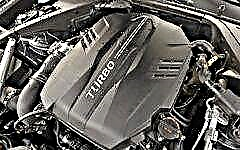

The content of the article:
- Steam as an engine of progress
- The first ferry cars
- "Alcohol car"
- From a moonshine still to a four-wheeled unit
- "Doble" of millionaires
- The fate of steam engines
- Today is
The era of gasoline cars, so familiar and reliable, still lasts. But world-renowned carmakers are already starting to produce economical and environmentally friendly electric vehicles, which sooner or later will oust cars with internal combustion engines from the market.
However, during its history, humanity has known other sources of energy - for example, steam engines, which were used in some types of machines.
Steam as an engine of progress

In the photo: Kyunho's steam engine
Milestones of the creation of steam engines:
- The first steam engine in history was conceived and implemented by an engineer By Hero of Alexandriawho lived two thousand years ago in Greece. He himself did not understand why he invented a toy-ball that revolved around its axis, set in motion by steam rising from below. The technology, having found no application, has sunk into oblivion for one and a half thousand years.
- Jesuit Ferdinand Verbst built and presented to the Chinese emperor (1672) a toy - a tiny self-propelled car powered by steam.
- Isaac Newton drew drawings of a steam cart, where, due to a boiler with a nozzle and manual steam release, the structure could move.
- Thomas Newkman created a steam engine similar to modern ones, only with a very large boiler, which he adapted as a machine for pumping out groundwater.
- James Watt brought to mind Newksman's design, attaching a condenser to it and looping the process of converting steam to water and vice versa. He managed to put the resulting unit on the frame and test the movement initiated by the steam. Having received a patent for an invention, he greatly tempered the ardor of other developers of a similar idea.
- Nicholas Joseph Cugno, an artillery French engineer, invented a self-propelled steam wagon for transporting guns. Inside the structure weighing under a ton was a copper cylinder, which was filled with steam, after which water was injected, and the resulting vacuum sucked in the piston.
The steam cart could only move for a kilometer, after which a "refueling" with boiling water was required. But it could carry up to two tons of cargo for this kilometer.
The command liked the idea, the designer was given the go-ahead and 20,000 francs to revise the idea. As a result, the cart learned to move at a speed of 7 km / h for a rather long time due to the installed firebox under the boiler. This speed was enough for the steam cart to make the first accident, ramming the wall of the house because of the wheel that caught the "wedge". The French "grandmother" of the steam car is now kept in the museum.
- Sylvester Roper created the first prototype of a motorcycle - a steam bicycle. The neighbors tried to appeal to the law enforcement officers, such a noise was made by the bicycle created by the inventor - but alas, there were no laws prohibiting riding on two wheels!
- Richard Trevithick, and later Walter Hancock, who finalized the idea, became the creators of the steam omnibus, a commercial vehicle capable of traveling up to 32 kilometers.
- Kazimir Yankevich from Russia also tried to create a car for a pair and even came up with a "fast-rolling" that could function both on coal and on water. Alas, the project was not implemented.
The first ferry cars

At the very beginning of 1906, driver Fred Marriott, driving a ferry car built at a production facility owned by the "Stanley Brothers" and prophetically named "Rocket", for the first time in history managed to accelerate to 205 km / h.
It sounded triumphant! After all, the car, driven by a ferry, overtook all vehicles, including airplanes. Having recorded another speed record of 240 km / h, the racer crashed to death.
Already the beginning of the twentieth century was marked by the fact that steam cars, mainly trucks, drove confidently on the roads. They differed from the first cars on gasoline by a number of factors:
- durability;
- reliability;
- omnivorous (they could work on any combustible fuel from coal to straw).
Steam engines were distinguished by a low speed mode (no more than 50 km / h) - they had to constantly have a large volume of water in stock, and the spent steam constantly escaped into the atmosphere. Steam cars were widely used in Europe until the early 1940s, and in Brazil they were mass-produced even a decade later.
The steam engines had significant disadvantages:
- solid fuel at the exit turned into a large ash heap;
- exhaust and smoke contained high concentrations of sulfur and soot;
- firing up the solid fuel boiler was lengthy, taking at least a couple of hours. Someone came up with the idea of heating houses by leaving steam engines connected to the heating system overnight. If he worked all night long, then the feromobile did not need to be re-energized - 15 minutes were enough for him to be able to continue moving again.
"Alcohol car"

It seemed to the engineers that the internal combustion engine was unsuitable for transport. It stalls when slowed down and cannot be started after opening the transmission.
The internal combustion engine was also unable to develop traction in a different speed range, it would not start without a "crutch" in the form of a transmission.
The car, launched by the ferry, seemed to mimic any change in the traffic situation itself. The increasing resistance caused the motor to slow down, increasing the torque in parallel. As the resistance decreased, the rotation increased. Therefore, the creators of ferry cars fought in every possible way to create a compact steam generator capable of moving the car without the participation of additional devices in the form of a clutch and gearbox.
They learned to fill the engines of the ferry vehicles with any liquid. Liquid-fuel ferry cars were able to start moving after 23 minutes from the engine warming up, and they needed 30 liters of gasoline and 70 liters of water to cover a hundred kilometers.
People have found out that burning fuel in an internal combustion engine cylinder emits a lot of toxic substances into the atmosphere. A small car with a gasoline engine is capable of producing so many harmful substances during an hour of operation that if a small space around it were closed, this would lead to the death of people nearby.
The steam generator burner is less toxic at the outlet - the fuel burns at unchanged rates, contributing to the complete completion of the reactions.
An important factor in the efficiency of a machine is the amount of fuel consumed. So, the American "star" on steam traction "Doble-Besler", assembled in the mid-1920s, had a mass of 2 tons with a tail. At the same time, fuel consumption was 18 liters per hundred kilometers. For its time, this was a very good indicator - moreover, it remained the benchmark for almost forty years.
The steam generator burner processed liquid in any form. The ferry car continued to run on kerosene and alcohol, ran on gasoline, fuel oil, even vegetable oil. And this was not at all an attempt to reduce the cost of the refueling process - it was just that Doble-type cars were omnivorous, but only available to millionaires.
From a moonshine still to a four-wheeled unit

In the photo: the Doble brothers
The steam generator was the most important element of the steam machine. The development was implemented by Detroit engineers, the Doble brothers. They connected ten flat coils in series, housed in a water-cooled steel casing.
The cool liquid was pumped into cooling pipes located around the high-temperature housing, where it was heated. This minimized heat loss.After that, the liquid filled the coils to boil, become steam with a temperature of 4.5 thousand degrees Celsius and a pressure of 120 atmospheres.
The Doble brothers sought to increase temperature as well as pressure, which together increased efficiency. The engineers managed to make the steam generator quite light and inexpensive.
Twin cylinders processed steam. First, it was pumped into the apex of a smaller diameter, where it expanded and generated energy. Then he "moved" to a larger cylinder, to its lower part, performing additional work.
The two stages of expansion proved to be extremely useful when the car drove through the streets. During the start of the movement and during acceleration, significant volumes of steam entered, but when there was no need for maximum energy output, they expanded once.
The spent vapors transferred heat to the cooled liquid tending to the steam generator. The vapor returned to the liquid state only in the condenser. Moisture entered the steam generator in portions, just enough so that the steam engine could make one or two piston movements. Therefore, in fact, the steam generator contained a small amount of water, which made it safe for an explosion.
If the tube broke, steam entered the furnace, turning off the burner. And even such a case happened only once, when the car suddenly stopped starting after two hundred kilometers. Repair and replacement of the failed coil took exactly one hour.
"Doble" of millionaires

Photo: ferry
Shortly before the outbreak of war by Germany in Europe, the current ZIL, which was then called the Stalin Moscow Automobile Plant, decided to produce an exclusive model of the car.
The body of the handsome man was decorated with mahogany. It stood on a chrome-nickel steel chassis manufactured by Packard. The Soviet designers took the Doble ferry car, assembled in 1924 by the American company Besler, as a model.
The movement was set by a steam generator and paired radiators. A fairly miniature ferry was attached to the rear axle, making up a single system with a differential. The clutches, transmissions and cardan shafts familiar to modern drivers were not required.
The speed could be controlled with a steam pedal. From time to time, it was only required to change the phase of the cessation of steam admission into the cylinder. After turning on the ignition, the car took 45 seconds to start moving. A couple more minutes, and the car could be accelerated to 150 km / h.
The ferry car moved smoothly and quietly. He came to the court of the Soviet elite, his trials continued after the conclusion of peace with Germany. One of the participants in the development of the Soviet version of "Doble", A.N. Malinin, was responsible for testing the sample.
For certain tests, treadmills are used in the automotive industry. The car is driven onto the stand so that the driving wheels are strictly on the drums. As a result, they spin, forcing the wheels to turn and imitate driving on the road. In this case, the machine is stationary with the engine running.
When test engineer Malinin and a huge authority in the theoretical automotive field, Professor Chudakov, got into the car, the latter pressed the buttons and fell silent. Five minutes later Malinin could not resist: "Isn't it time to start?" To which the professor replied: "We have been driving for a long time, the speedometer shows 20 kilometers." The speed was quite decent, but in order for the ear to catch at least some sound of the steam generator, it was necessary to closely press in the exhaust pipe.
Seventy liters of water in excess was enough for half a thousand kilometers, and problems requiring the release of steam were extremely rare. Therefore, in the car, in which all the parts were precisely and precisely fitted to each other, nothing made noise.
The fate of steam engines

If ferry cars were so comfortable and good, why exactly ICE cars have managed to occupy a niche in the automotive environment?
The fact is that the engine for a couple had a very complex automation and a lot of all sorts of complementary units. At the same time, its manufacture came out more expensive, and it gave less efficiency.
Another drawback was its large size, in particular - a tank with a supply of water. At that time, no one thought about environmental friendliness, as a result, the steam engine was gradually ousted from the market by cheaper cars with internal combustion engines.
Today is

Photo: model Inspiration
Pushed out of the market, ferry cars no, no, yes, and excite the minds of engineers. In 2009, on the track, the Inspiration steam car, predatory and streamlined, managed to set a new record for steam cars - 225 km / h.
The power of the car was 360 hp, and the movement was started by two turbines with a pressure of 40 bar, which were pumped by 12 modern boilers.
The question remains - what would we be driving around today, if humanity had been concerned with the problem of preserving the environment fifty years earlier?











